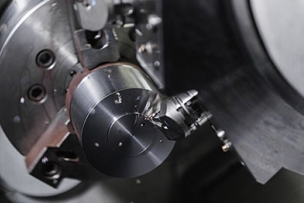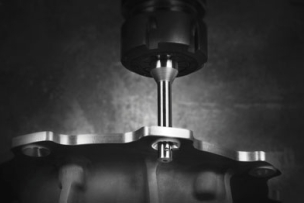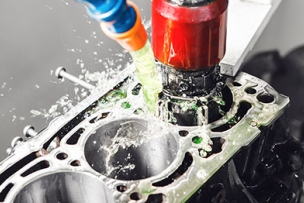Leveraging a proprietary Mitutoyo optical system alongside traditional sensor technology, the scanners deliver 2D profile measurements as well as comprehensive 3D inspections for a wide range of industries, including semiconductors, automobiles, medical equipment, and even food.
Expanded Product Line
The first product in the series, the SurfaceMeasure 1008S, was introduced in 2024. It’s guaranteed for an accuracy of 20 microns along with a vertical-axis repeatability of 0.5 micron.
Two new models were launched in May 2025. The SurfaceMeasure 0303S is a higher-accuracy scanner (9 microns), with a much smaller field of view. “This is ideal for inspecting cell batteries, microchips and other components where you really need to get good details and tight tolerances,” Browner says.
On the other end of the spectrum is the SurfaceMeasure 2929S, which is a long-range model with roughly 2.5 times the field of view of the SM 1008S, and 60-micron accuracy.
Browner expects the long-range model to be attractive to facilities that are making large industrial components such as crankshafts. “Instead of saying, ‘We can do this, but you might have to use five or six sensors,’ now we can get back down to using one or two, so this will be a lot more cost-effective for certain kinds of manufacturers,” he says.
All three models can be attached to stationary as well as flexible inspection points, including the arms of robotic equipment, for real-time quality control. The scanners can also be used alone or in an array.
A Collaborative, Customized Solution
The big difference between the scanners and a lot of Mitutoyo’s other products such as CMMs and vision machines, Browner says, is that they aren’t a fully built product that you buy off the shelf, but rather a collaborative solution that requires working with manufacturers to help solve their specific challenges.
This involves first defining what you want to measure, then designing and building the entire process around the sensor to fit your specific needs.
He likens it to the difference between buying a car and buying an engine. “When you buy a car, it’s ready to go. All you need is a driver. But a sensor is like the engine of the car. You still need to build the rest of the car,” Browner says.
A sensor can be integrated into an existing system, or a new system can be created. “When a customer is deciding they want a system, it can be dedicated to one job or it can be a tool for many jobs,” Browner adds. “Integrators, often third-parties, are regularly used to help with this process.”
Beyond Quality Control
Browner says that one of the biggest benefits of the scanners is that they can facilitate much faster troubleshooting of manufacturing problems. By catching quality issues faster and making real-time adjustments, companies can avoid producing large batches of potentially defective parts.
“What we’re hearing is that a lot of companies expect to use it for condition monitoring,” Browner says. For example, a molded plastics product manufacturer says they’ll be better able to identify where exactly in the production line a part is starting to go bad.
“They realized that by adjusting and going from one sensor to two sensors, they can start seeing bulges and where heat issues are, and they can kick that part out and be done with it. At the same time, they know exactly where something is going wrong in the mold,” Browner says. By getting to the root case faster and using that information to make corrections, they’ll be able to eliminate waste.
In this way, the scanner essentially transforms quality control from a reactive to a proactive process, improving both speed and precision simultaneously.
Some Unexpected Applications
When the SurfaceMeasure 1008S first came out, Browner says he was surprised to get inquiries from the food industry.
“Early on, we were contacted by a company that makes little loaves of French bread, and they wanted to monitor the output so that the loaves weren’t too big or too small,” he says.
“More recently, an R&D facility involved in making potato chips reached out to us, and neither of those were on anybody’s radar,” Browner adds. “But it makes sense because food manufacturers are concerned about the same things that parts manufacturers are concerned about.”
For now, food isn’t expected to be a big growth area for the scanners, but Browner says he’s interested to see how some of the applications pan out and will then decide whether it makes sense to actively market to more food manufacturers.
User-Friendly and Interesting
The scanners, which include an image sensor, camera lens and Class 2 blue laser, are controlled through a simple web-based interface. Most companies report that the product is easy to use and fairly intuitive, Browner says.
“People have said they’ve been able to pull things out of the manual, but depending on some of the modes, you can actually just fumble your way through it, and that’s actually how I started learning with it,” he says. “There’s a thousand-page manual, but you can’t really look at the scanner without using it at the same time, so you just start playing with it.”
Operators who are building the program to do the inspection routine will require more detailed instruction, but the company has training available for those who need it.
Amid a workforce shortage and declining interest in manufacturing among younger generations, Browner says the scanner highlights the tech-driven side of the industry—something that tends to resonate with people in their 20s and 30s.
Instead of doing repetitive, hands-on tasks like turning wrenches or standing on a production line, workers are programming and scanning parts using advanced tools. “It turns it into a little bit more techie type of job,” Browner says.
“Young people these days are more motivated by what makes them feel good, along with paying the bills and all the other stuff. So let’s make the job more interesting.”
What innovative ways could your facility use Mitutoyo’s laser scanners to reduce waste and improve productivity? Tell us in the comments below.





Talk to Us!
Leave a reply
Your email address will not be published. Required fields are marked *